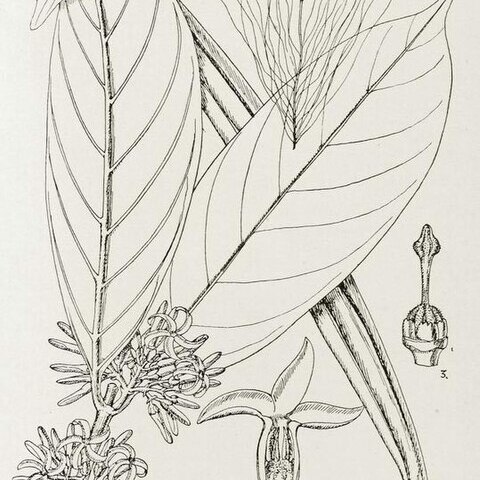Trees or shrubs, evergreen, bark and pith with white latex, domatia present. Leaves opposite, margin undulate or revolute. Cymes axillary or terminal, many flowered. Calyx deeply divided, with basal glands inside. Corolla salverform, tube swollen on 1 side at middle; throat much constricted, without scales; lobes overlapping to right. Stamens inserted near middle of corolla tube; anthers sagittate, included, adherent to pistil head, lobe with an empty tail; disc cup-shaped, deeply 5-cleft. Ovaries 2, free; ovules numerous, pendulous. Style glabrous; pistil head club-shaped. Follicles 2, divaricate. Seeds with a slender comose beak directed toward base of fruit.
Stamens included; filaments very short or absent, ventrally densely hirto-pubescent, dorsally glabrous; anthers narrowly triangular with a very short point at the acuminate apex, sagittate at the base, glabrous, 2-celled, introrse; connective dorsally appressed-pubescent, ventrally at the base stiffly coherent with the clavuncula.
Leaves opposite, petiolate, those of a pair connate into a short ocrea, with many small colleters in two or three rows in the axils; lamina ovate, elliptic or oblong, decurrent into the petiole, acuminate at the apex, entire, glabrous above; often domatia in the axils of the secondary veins; margin both undulate and revolute.
Corolla tube ventricose at the middle, inside thickened at the throat, densely hirto-pubescent from the insertion of the stamens to the level of the apex of the ovary, with an indumentum which gradually becomes thinner and shorter; lobes overlapping in bud to the right, often auriculate at the left, entire, recurved.
Fruit of two follicles which are connate at the base, green and glossy when young, turning grey-brown and woody when maturing, striate; follicles adaxially flattened and there dehiscent, abaxially convex, sometimes slightly curved; wall woody, thick, outside grey-brown smooth and yellowish-brown inside.
Evergreen trees or shrubs, with white sticky latex; bark smooth, sometimes with a few lenticels, greenish-brown to grey; wood of low density, soft; branches terete, sometimes lenticellate, very dark brown; branchlets smooth, terete or laterally compressed with a longitudinal groove below the ocrea.
Ovary composed of 2 almost-free carpels which are united by the base of the style; placenta adaxial, 2-lobed; style not split at the base, with two longitudinal grooves, thickened below the clavuncula; clavuncula grading into the stigma, together ovoid; stigma conical.
Seed slender, fusiform, with the apex rostrate; rostrum at least above the middle with long straight hairs enveloping the seed within the fruit; testa rugose; endosperm white, surrounding the embryo; embryo white, straight, about 0·9 times as long as the seed.
Sepals free, thick, ovate or nearly so, obtuse or subacute at the apex, often membranous and minutely ciliate at the margin, inside with a single row of colleters at the base.
Inflorescences congested, terminal and axillary, cymose, much shorter than the leaves; peduncle short; bracts ovate or elliptic, often with small colleters in the axils.
Disk 5-lobed; lobes truncate or acute, minutely toothed at the apex.
Ovules pendulous, 200–350 in each carpel.
Flowers actinomorphic, fleshy, fragrant.

